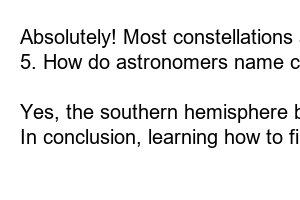별자리 찾는법
Title: How to Find Constellations: A Beginner’s Guide to Stargazing
Introduction:
Have you ever gazed up at the night sky and wondered about the stories hidden among the stars? Constellations, formations of stars that create meaningful shapes, have captivated humans for centuries. If you’ve ever wanted to explore the wonders of the night sky and decipher its secrets, this guide will show you how to find constellations like a pro.
1. Understanding Constellations:
Before diving into stargazing, it’s essential to have a basic understanding of what constellations are. These patterns are like celestial connect-the-dots, formed by the perceived positions of stars in the sky. They can represent mythical creatures, animals, objects, or even famous figures from history.
2. Preparing for Stargazing:
To make the most out of your stargazing adventure, it’s crucial to plan ahead. Check the weather forecast for a clear and cloudless night, and choose a location away from city lights for optimal visibility. Bring a comfortable blanket or chair, a star chart or mobile app for reference, and warm clothing for those chilly evenings.
3. Learning to Read the Stars:
To find constellations, it’s essential to familiarize yourself with the stars themselves. Begin by identifying the prominent stars and their relative positions. Observing the brightness, color, and grouping of stars will help you navigate the night sky and locate specific formations.
4. Identifying Popular Constellations:
There are dozens of constellations visible to the naked eye, but a few stand out as crowd favorites. Learn how to spot popular constellations such as Orion, Ursa Major (the Big Dipper), and Cassiopeia. Each of these constellations holds significant stories from different cultures and mythologies.
5. Using Constellation Maps and Mobile Apps:
Technology has made stargazing more accessible than ever. Utilize constellation maps, easily available online or at your local library, which provide a visual representation of the night sky. Alternatively, mobile apps like SkyView or Night Sky can offer real-time guidance, showing you the exact position of constellations as you move your device around.
6. Finding Constellations through Star Patterns:
If you’re keen on a more hands-on approach, try connecting stars to form recognizable patterns. **Trace the imaginary lines** that create Orion’s belt, or the distinct ‘W’ shape of Cassiopeia. By following these star patterns, you can locate and identify constellations without relying solely on charts or apps.
FAQs:
1. How many constellations are there?
Currently, there are 88 recognized constellations in the night sky.
2. Can constellations be seen from both hemispheres?
Although some constellations are visible worldwide, many are region-specific due to Earth’s rotation and tilt.
3. Do constellations change over time?
While stars themselves remain relatively fixed, constellations can shift their positions over thousands of years due to Earth’s axial precession.
4. Can I see constellations without a telescope?
Absolutely! Most constellations are visible to the naked eye, and a telescope is not necessary to appreciate their beauty.
5. How do astronomers name constellations?
Many constellations have names rooted in ancient mythology, while others bear names of famous scientists or explorers.
6. Are there different constellations in the southern hemisphere?
Yes, the southern hemisphere boasts unique constellations such as the Southern Cross and the Magellanic Clouds.
In conclusion, learning how to find constellations can open up a new realm of fascination and wonder. By understanding the science behind these celestial formations and utilizing tools like maps or mobile apps, you can embark on a mesmerizing journey through the cosmos, connecting with ancient stories and unraveling the mysteries of the night sky. So grab your stargazing gear, find a cozy spot, and let the constellations guide you on an unforgettable adventure.

